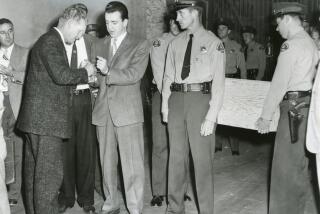The Wild West : Executions Staged by Vigilantes Marred Justice in the 1880s
California had little trouble executing its condemned murderers in the late 1800s--a violent period in San Diego history, particularly in rural and isolated North County areas. After brief trials, most convicted slayers from San Diego were hanged on the grounds of the county courthouse. Appeals and stays of execution were rare. (After 1893, the condemned from all counties were executed at San Quentin. The first man executed at the state prison was a San Diegan--Jose Gabriel, hanged for murdering a farm family.)
Occasionally, public anger over a heinous crime provoked “popular justice” or “vigilantism.” Lynching by vigilantes proved to be a popular alternative in the mid-19th Century to court trials.
The year 1878 was a busy one for “popular” justice. In the gold rush town of Julian, an Indian named Juan La Cruz was jailed for attacking a woman and her child while he was “crazed with drink.” Although the woman and child were unhurt, nightfall brought an excited crowd to the town jail, where they demanded the prisoner. When the guard refused, the mob threw a sack over his head and seized La Cruz.
The next morning, the body of Juan La Cruz was discovered hanging in the woods nearby. As a crowd gathered, one witness was reported to have said: “You’ve done a good job, you reformers. Now why don’t you hang the man who sold the whiskey to the Indian?”
In July, a rancher named William Palmerston was attacked and killed by an intruder in his home in the San Jacinto Valley. The alleged slayer, identified as Refugio Baca, was captured the next day by a sheriff’s posse. Baca was placed in a Temecula jail cell and waited for a justice court hearing scheduled for the following morning.
The local citizenry planned a different future for Baca. That night a crowd of “20 or 30 masked men,” carrying shotguns, rifles and pistols, removed Baca from his guards, fastened a rope around his neck and hanged him from the limb of a cottonwood tree. The following day a hurriedly summoned coroner’s jury rendered its verdict: “Refugio Baca came to his Death by hanging by the neck to a rope the same being executed by unknown Parties, the same Generally known as a Mob.”
Later that year, an Indian “desperado” known as Jose Laguna, alias “Ramon,” was arrested near Warner’s Ranch and brought to San Diego. Charged with attempted murder in another county, a nervous Ramon reportedly asked his courthouse jailer if there “were vigilantes here like there was in Los Angeles.”
The following day he was found dangling from the rafters of his cell with his feet bound and his hands tied behind him. A coroner’s jury rendered a remarkable verdict: “He came to his death by hanging himself.”
Nearly all known cases of vigilante action in San Diego County in the 19th Century involved either Hispanics or Indians as victims. And, in each incident, the coroner’s jury failed to indict perpetrators.
More to Read
Sign up for Essential California
The most important California stories and recommendations in your inbox every morning.
You may occasionally receive promotional content from the Los Angeles Times.









